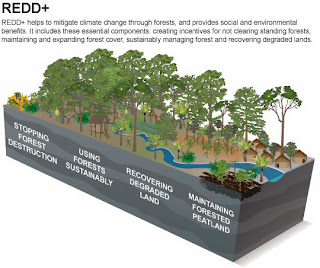The emmission of carbon of converted forest area are predicted to account for one-fifth of current global emmission. As one of the least expensive mitigation options and the global climate protection regime for addressing the above is by implementing REDD (Reduced Emissions from Deforestation and Forest Degradation) (CIFOR 2007). Furthermore, the Thirteenth Conference of the Parties (COP 13) to the United Nations Framework Convention on Climate Change (UNFCCC) in 2007 laid the foundation for the post-2012 climate protection regime to include REDD in developing countries. After that, the mechanism of REDD is developed comprehensively to be REDD+ including the role of conservation, sustainable management of forests and enhancement of forest carbon stocks in developing countries.
REDD+ is a global mechanism for reducing emissions from deforestation and forest degradation, and for the conservation and sustainable management of forests and the enhancement of forest carbon stocks in developing countries. REDD+ enables the transfer of funds from developed to developing countries that are willing and able to undertake REDD+ actions (IISD 2012). According to the UN REDD Programme Strategy 2011-2015, UN-REDD+ activities are categorized into the following three phases:
• Phase 1 (Readiness): Development of national strategies or action plans, policies and measures, and capacity building
• Phase 2 (Demonstration): Implementation of national policies and measures and national strategies or action plans that could involve further capacity building, technology, development and transfer, and results-based demonstration activities
• Phase 3 (Result-based actions): Results-based actions that should be fully measured, reported and verified.
Understanding the finacing needs is an imperative thing in REDD+ mechanism. Two types of financing needs will arise regardless of the final design of the REDD mechanism (Eliasch 2008): up front capacity-building (readiness) costs and on going emission reduction costs. According to REDD+ Safeguard Information System (2012), to attract and sustain funding, REDD+ finance must operate within a governance framework capable of demonstrating compliance with social, environmental and governance safeguards.
 |
| REED+ scheme |
From three phases of the REDD+ Programme, REDD+ finance will come from multiple sources that follow different rules and target different actors. REDD+ finance has several sources – public, private, national and international – as well as different mechanisms (e.g. taxes, carbon markets and auctioning of allowances) (CIFOR 2012). Public sector finance is defined here as revenue generated through a mechanism controlled by a public body, while private sector finance does not enter the hands of the public sector. In addition, over the course of international climate change negotiations on REDD+, private sector engagement has repeatedly been identified as a key component in moving forward (IISD 2012).
From early, there is a tight debate to recognise a variety of financing resources which includes voluntary contributions, market-based and fund-based finance will be needed for REDD+ (Dutschke et al. 2008 Grondard et al. 2008 Meridian Institute 2009 CIFOR 2009), particularly in the early phases. In other hand, there are four major challenges associated with REDD+ finance (CIFOR 2012):
• Defining REDD+ costs and estimating the financial needs of REDD+
• Mobilising sufficient international and national finance to cover the costs of REDD+ policies and measures
• Allocating and disbursing REDD+ finance efficiently, effectively and equitably to produce clear and measurable results
• Matching the requirements and needs of policy makers and other stakeholders in developing countries with those of donors or investors in REDD+, and creating and/or strengthening the institutions needed to implement policies and manage REDD+ funds.
18 Comments
quite good one and thanks for sharing
Posted 30-12-2013 17:18
thanks for sharing
Posted 30-12-2013 16:24
This is amazing! Truly worth to read and share!
Posted 29-12-2013 14:40
thanks for sharing
Posted 28-12-2013 01:48
Great report.
Posted 27-12-2013 18:33
very informative
Posted 27-12-2013 11:44
global issue
Posted 26-12-2013 23:27
its issues are increasing today
Posted 26-12-2013 22:21
Thanks for the article.
Posted 26-12-2013 17:00
Informative.
Posted 26-12-2013 17:00
Thanks for sharing :)
Posted 26-12-2013 13:39
thanks for sharing.
Posted 25-12-2013 19:41
Nice article.
Posted 25-12-2013 16:30
good report Achamad
Posted 25-12-2013 11:17
It is really illuminating thanks for ur sharing
Posted 25-12-2013 02:49
Very informative , thanks Achmad.
Posted 24-12-2013 22:22
nice article
Posted 24-12-2013 20:56
Thanks for sharing
Posted 24-12-2013 20:44